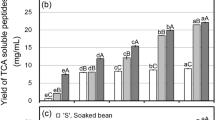Abstract
Quality of soybeans and soybean meals (SBM) from non-US and US origins were compared. The US SBM was more consistent with higher digestibility (by KOH solubility), lower fiber and better quality of protein (by essential amino acid levels) than SBM of other major export origins (Argentina, Brazil and India). Protein quality carried through from whole soybeans to SBM, for a given origin. While the protein content was higher for the SBM from Brazil, the percentage of total digestible amino acids was highest for the SBM from the US and China. The US SBM had the highest content (total) of five essential amino acids for both poultry and swine feed uses, which when coupled with higher digestibility, would give US meal an advantage in rations balanced on amino acids. The mean particle size for all SBM from all origins was within the desirable range specified by nutritionists. The US soybeans were lower in protein than Brazilian soybeans, but higher than Argentine soybeans. The crude protein disadvantage of US soybeans was offset by higher concentrations of the essential amino acids in the lower protein soybeans. The US soybeans were lower in oil content than soybeans from either of the South American origins. Average protein and oil contents of US soybeans were consistent with the 2003 and 2004 annual soybean quality surveys. The US SBM held an advantage in digestibility and concentration of key amino acids in all three studies.



Similar content being viewed by others
References
Soy Stats 2005, http://www.soystats.com/2005/Default-frames.htm
Grieshop CM, Fahey GC Jr (2001) Comparison of quality characteristics of soybeans from Brazil, China and the United States. J Agric Food Chem 49:2669–2673
Moizzudin S (2003) Soybean meal quality in US and world markets. MS Thesis, IA State University
Park HS, Hurburgh CR Jr, Improving the US position in world soybean meal trade. MATRIC working paper 02-MWP 7, http://www.card.iastate.edu/publications/DBS/PDFFiles/02mwp7.pdf
Batal AB, Douglas MW, Engram AE, Parsons CM (2000) Protein dispensability index as an indicator of adequately processed soybean meal. J Poult Sci 79:1592–1596
Araba M, Dale NM (1990) Evaluation of protein solubility as an indicator of overprocessing soybean meal. J Poult Sci 69:76–83
Karr-Lilienthal LK, Mershen NR, Grieshop CM, Flahaven MA, Mahan DC, Fastinger ND, Watts M, Fahey GC Jr (2004) Ileal amino acid digestibilities by pigs fed soybean meals from five major soybean-producing countries. J Anim Sci 82:3198–3209
AOCS (1999) Official methods and recommended practices of the AOCS, 5th edn. AOCS, Champaign
AOAC (1990) Official methods of analysis, 15th edn. AOAC, Arlington
AACC (2000) Approved methods of American association of cereal chemists, 10th edn. American Association of Cereal Chemists, St Paul
ASAE (1997) ASAE standards, 44th edn. American Society of Agricultural Engineers, St Joseph
Brumm TJ, Hurburgh CR Jr (2004) Quality of the 2003 soybean crop from United States, http://www.soybeans.umn.edu/pdfs/2003ProteinSurvey/2003USSoybeanQuality_final.pdf
Brumm TJ, Hurburgh CR Jr, Rippke G (2005) Quality of the 2004 soybean crop from United States http://www.asasoya.org/News/2004US20SBQualityFINAL.pdf
Baize J (2000) Global soybean meal sampling and analysis activity (final report) http://www.soymeal.org/worldlitarticles_new/globalsmsampling.html
Trading Rules (2004) National oilseed processors association, http://www.nopa.org/content/trading/trading.html
Specifications for soybean meal http://www.ussoyexports.org/resources/soyinfo/SBMSpecs.pdf
Non-protein nitrogen poisoning: introduction. The Merck veterinary manual http://www.merckvetmanual.com/mvm/index.jsp?cfile=htm/bc/212300.htm
DiCostanzo A, Murphy M (1994) Strategies for feeding mycotoxins and mold-contaminated grains to cattle. Beef Cattle Management Update 32:1–11 http://www.extension.umn.edu/beef/components/publications/bcmu32.pdf
Kopinski J, Amino acids for pig diets. Department of primary industries and fisheries, Queensland http://www.dpi.qld.gov.au/pigs/4374.html
Ingredient analysis table (2002) Feedstuffs 74(28):16
Research and reviews: swine, particle-size evaluation of grain fed on Ohio swine operations. The Ohio State University extension and research bulletin, http://www.ohioline.osu.edu/sc185/sc185_10b.html
Acknowledgments
This journal paper of the IOWA Agriculture and Home Economics Experiment Station, Ames, IA, USA, Project No. 3,261 was supported by Hatch Act and State of IOWA funds. Research was also supported by checkoff funds from the United Soybean Board through the American Soybean Association International Marketing Division.
Author information
Authors and Affiliations
Corresponding author
About this article
Cite this article
Thakur, M., Hurburgh, C.R. Quality of US Soybean Meal Compared to the Quality of Soybean Meal from Other Origins. J Am Oil Chem Soc 84, 835–843 (2007). https://doi.org/10.1007/s11746-007-1107-8
Received:
Revised:
Accepted:
Published:
Issue Date:
DOI: https://doi.org/10.1007/s11746-007-1107-8



